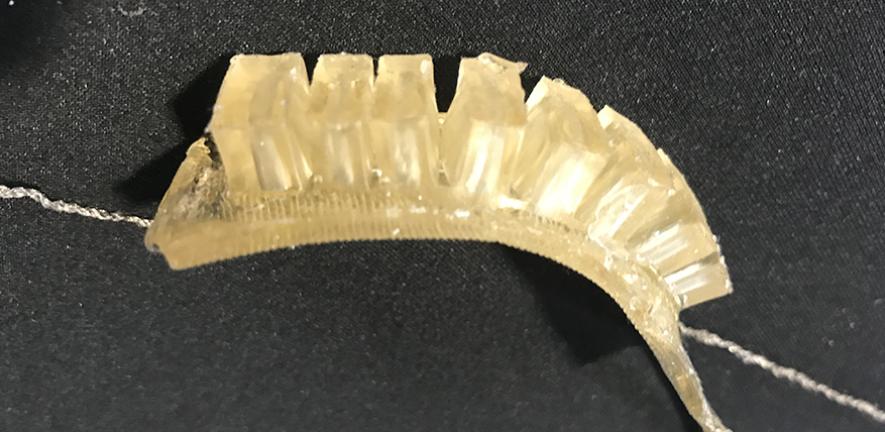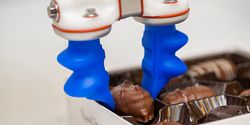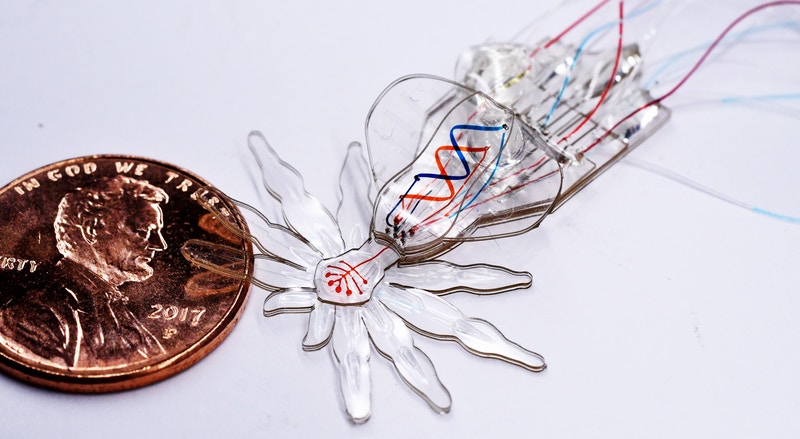Sheet-Jamming Technology Revolutionizes Soft Robotics Grippers
To improve the performance of suction grippers, a new concept called sheet-jamming phenomena has been introduced. This technology has been used to create a suction gripper that is lightweight and can lift almost twice the weight of regular suction cups.
Researchers develop first self-healing, electrically conducive, soft material
Carmel Majidi has engineered a soft material with metal-like conductivity and self-healing properties that, for the first time, can support power-hungry devices. Majidi's team introduced the material in three applications: a damage resistant snail-inspired robot.
Soft Grippers Can Handle Small and Delicate Parts With Greater Ease
This opens up new possibilities in robotic automation and even some cutting edge robotics applications. From injection molding to strawberries and even robotic surgeries, soft gripper technology is making it easier than ever before for robots to pick up anything.
Self-healing materials for robotics made from 'jelly' and salt
Researchers have developed self-healing, biodegradable, 3D-printed materials that could be used in the development of realistic artificial hands and other soft robotics applications.
Dancing with the Light: A New Way to Make Crystals Bend by Shining Light
Scientists propose a novel mechanism for inducing high-speed bending in thick crystals by heating them up with light
Toyota Research Institute Shares Design to Help Advance the Field of Soft Robotics
The Toyota Research Institute (TRI) is helping to accelerate the field of soft robotics by sharing the design source files and full build instruction for its innovative domestic robot hands.
Co-Learning of Task and Sensor Placement for Soft Robotics
Deep-learning technique optimizes the arrangement of sensors on a robot's body to ensure efficient operation.
The Incredible Potential of Soft Robotics
Alternatives to hard components hold potential for applications from surgery to space exploration
A Guide to Self-Healing Robots
More flexible materials are necessary for safer collaborative work alongside humans and delicate tasks usually performed by humans, such as picking fruit and vegetables or performing minor surgeries.
The Power of Adaptive Robotic EOAT
The challenge is that traditional robots have been designed to perform a single task extremely efficiently. But when the item or the task changes these traditional machines need to be reintegrated and reprogrammed.
A Step Closer to Self-Aware Machines - Columbia engineers create a robot that can imagine itself
Columbia Engineering researchers have made a major advance in robotics by creating a robot that learns what it is, from scratch, with zero prior knowledge of physics, geometry, or motor dynamics.
ASU's Southwest Robotics Symposium previews the new technology guiding the next wave of human-robot interaction
"We can rely on the brain of the human and the muscles, eyes and sense of touch of the robot in places where humans cannot, or should not, be," said Khatib. "For example, we will be able to safely repair underwater structures
"Robotics Skins" turn everyday objects into robots
Developed in the lab of Yale's Rebecca Kramer-Bottiglio, NASA-inspired robotic skins enable users to turn soft objects - a stuffed animal or a foam tube, for instance - into robots.
Soft Multi-functional Robots Get Really Small
A new approach for fabricating soft materials at the millimeter scale paves the way to a new generation of flexible microrobots for medical and environmental tasks.
This Robot Has Soft Hands. It Could Be the Future of Sustainable Production
Traditional robots have been designed to perform a single task extremely efficiently. But when the item or the task changes, which is often the case with food, these traditional machines need to be reintegrated and reprogrammed
Records 1 to 15 of 42
Featured Product

OnLogic Karbon 520 Series of Scalable Rugged Computers
The OnLogic Karbon 520 Series of rugged computers is purpose-built to deliver unwavering performance and reliability in the face of extreme temperatures, vibration, and dynamic power conditions. Powered by the latest Intel® Core™ Ultra processors and validated by MIL-STD-810H testing, the Karbon 520 Series makes it possible to deploy dependable computing for AI at the edge, advanced automation, or critical remote and in-vehicle applications in even the most challenging environments.
Robotics and Automation - Featured Company

TM Robotics (Americas) Inc
TM Robotics, in partnership with Shibaura Machine, formerly known as Toshiba Machine until 1st April 2020, offers a comprehensive range of industrial robots ideally suited for high-precision assembly, machine loading/unloading and material-handling applications that can be dust proof, clean room, or IP65/67. The company's extensive product line starts with a Cartesian solution available in thousands of combinations from single actuators to four-axis solutions; six-axis solutions that can include precise vision-control; and a complete range of SCARAs from low cost to the industry-leading SCARA with 1200-mm reach that can carry up to 20 kgs. TM Robotics sells and services robots throughout Europe, the Middle East, India, Russia, and Africa, as well as North, Central, and South America, from headquarters in Hertfordshire, England and Elk Grove Village, IL, USA. For more information, visit www.tmrobotics.com or follow us on Twitter, LinkedIn and YouTube.



.jpg)











